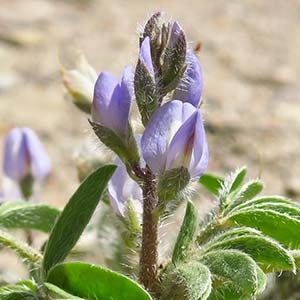|
intermountain lupine, low lupine, rusty lupine
|
Mohave lupine, Mojave lupine, Mojave royal lupine
|
| Herbs, annual, 0.5–2 dm, sparsely pubescent to pilose, hairs more than 1 mm. |
Herbs, annual, 1–3 dm, usually glabrous, sometimes sparsely pubescent when young, rarely at anthesis, hairs less than 0.5 mm. |
short and tufted or erect, branched from base or near middle. |
basally branched or unbranched. |
cauline, often crowded near base; stipules well developed; petiole 1–9 cm; leaflets 5–9, blades 10–40 × 5–10 mm, adaxial surface glabrous. |
basal; petiole 2–12 cm; leaflets 5–9, blades bright green, 8–24 × 3–10 mm, adaxial surface glabrous. |
8–12-flowered, 2–11 cm, shorter than or slightly exceeding foliage; flowers spirally arranged. |
4–25 cm; flowers spirally arranged. |
0–3.5 cm; bracts persistent, straight, 2–5 mm. |
hollow, 6–15 cm; bracts persistent, straight, 2–4 mm, tips sparsely ciliate. |
1–3.5 mm. |
3–7 mm. |
5–12 mm; calyx abaxial lobe entire, 5–6 mm, adaxial lobe cleft, 2.5–4 mm; corolla vivid blue, sometimes paler or white, sometimes bicolored, banner spot white or yellowish, keel glabrous. |
7–10 mm; calyx lobes sometimes ciliate at tips, abaxial lobe entire, 4–5 mm, adaxial lobe rounded or shallowly 2-toothed, 3–3.5 mm; corolla deep blue-purple, banner spot white or yellow becoming magenta, keel glabrous. |
1.5 cm, constricted between seeds, thinly pilose to coarsely hirsute. |
1.5–2.5 cm, adaxial suture undulate and ciliate with long dense hairs, sides with a few short hairs becoming scaly on drying. |
persistent, disclike, sessile. |
persistent, disclike, sessile. |
2, wrinkled or ridged. |
2–6, ridged. |
|
|
|
|
|
Flowering spring. |
|
Creosote bush scrub, Joshua tree woodland, sandy desert flats, open areas. |
|
500–1600 m. (1600–5200 ft.) |
|
w North America; c North America
|
AZ; CA; NV
|
Varieties 3 (3 in the flora). Lupinus pusillus is a highly variable species, with the varieties intergrading. (Discussion copyrighted by Flora of North America; reprinted with permission.) |
The fresh flowers of Lupinus odoratus smell like violets. Pilose plants can be confused with L. flavoculatus. Lupinus odoratus occurs in the Mojave Desert region of California, northward to Inyo and Mono counties, and eastward into southern Nevada and Mohave County, Arizona. The name Lupinus odoratus A. Heller is to be proposed for conservation against L. odoratus F. Dietrich (1836), a likely synonym of L. nanus. (Discussion copyrighted by Flora of North America; reprinted with permission.) |
1. Peduncles 0–1 cm; racemes shorter than foliage; flowers 6–8 mm. | var. intermontanus |
1. Peduncles usually 1–3.5 cm; racemes equal to or longer than foliage; flowers 7–12 mm. | → 2 |
2. Pedicels and calyx tubes strigose. | var. pusillus |
2. Pedicels and calyx tubes glabrous. | var. rubens |
|
|
| FNA vol. 11. |
FNA vol. 11. |
| Fabaceae > subfam. Faboideae > Lupinus |
Fabaceae > subfam. Faboideae > Lupinus |
L. adsurgens, L. affinis, L. albicaulis, L. albifrons, L. andersonii, L. angustiflorus, L. antoninus, L. apertus, L. arboreus, L. arbustus, L. arcticus, L. argenteus, L. arizonicus, L. benthamii, L. bicolor, L. brevicaulis, L. breweri, L. cervinus, L. chamissonis, L. citrinus, L. concinnus, L. constancei, L. covillei, L. croceus, L. dalesiae, L. diffusus, L. duranii, L. elatus, L. elmeri, L. excubitus, L. flavoculatus, L. formosus, L. fulcratus, L. gracilentus, L. grayi, L. guadalupensis, L. havardii, L. hirsutissimus, L. huachucanus, L. hyacinthinus, L. kingii, L. kuschei, L. lapidicola, L. latifolius, L. lepidus, L. leucophyllus, L. littoralis, L. longifolius, L. ludovicianus, L. luteolus, L. magnificus, L. malacophyllus, L. microcarpus, L. nanus, L. neomexicanus, L. nevadensis, L. nipomensis, L. nootkatensis, L. obtusilobus, L. odoratus, L. onustus, L. oreganus, L. pachylobus, L. padrecrowleyi, L. peirsonii, L. perennis, L. polyphyllus, L. pratensis, L. rivularis, L. sabineanus, L. sericatus, L. sericeus, L. shockleyi, L. sierrae-blancae, L. sparsiflorus, L. spectabilis, L. stiversii, L. subcarnosus, L. succulentus, L. sulphureus, L. texensis, L. tidestromii, L. tracyi, L. truncatus, L. uncialis, L. villosus, L. westianus |
L. adsurgens, L. affinis, L. albicaulis, L. albifrons, L. andersonii, L. angustiflorus, L. antoninus, L. apertus, L. arboreus, L. arbustus, L. arcticus, L. argenteus, L. arizonicus, L. benthamii, L. bicolor, L. brevicaulis, L. breweri, L. cervinus, L. chamissonis, L. citrinus, L. concinnus, L. constancei, L. covillei, L. croceus, L. dalesiae, L. diffusus, L. duranii, L. elatus, L. elmeri, L. excubitus, L. flavoculatus, L. formosus, L. fulcratus, L. gracilentus, L. grayi, L. guadalupensis, L. havardii, L. hirsutissimus, L. huachucanus, L. hyacinthinus, L. kingii, L. kuschei, L. lapidicola, L. latifolius, L. lepidus, L. leucophyllus, L. littoralis, L. longifolius, L. ludovicianus, L. luteolus, L. magnificus, L. malacophyllus, L. microcarpus, L. nanus, L. neomexicanus, L. nevadensis, L. nipomensis, L. nootkatensis, L. obtusilobus, L. onustus, L. oreganus, L. pachylobus, L. padrecrowleyi, L. peirsonii, L. perennis, L. polyphyllus, L. pratensis, L. pusillus, L. rivularis, L. sabineanus, L. sericatus, L. sericeus, L. shockleyi, L. sierrae-blancae, L. sparsiflorus, L. spectabilis, L. stiversii, L. subcarnosus, L. succulentus, L. sulphureus, L. texensis, L. tidestromii, L. tracyi, L. truncatus, L. uncialis, L. villosus, L. westianus |
|
|
|
L. odoratus var. pilosellus |
| Pursh: Fl. Amer. Sept. 2: 468. 1814[1813] |
A. Heller: Muhlenbergia 2: 71. (1905) |
| |
